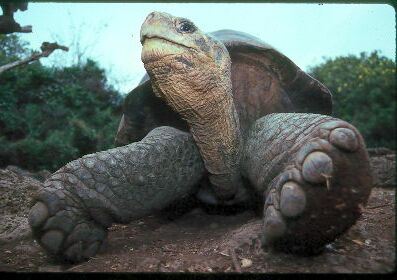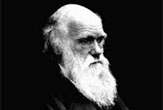
In 1837, Charles Darwin sketched a stick-figure tree in a page of Notebook B, one of many private notebooks in which he worked out the details of a new theory he was developing. The tree had spindly branches and a single root labeled with the number "1."
Scrawled at the top of the page, in Darwin's cursive handwriting, are the words "I think."
Notebook B will be one of many items on display in "Darwin," a new exhibit opening on Nov. 19 at the American Museum of Natural History (AMNH) in New York.
"Darwin" will be the most comprehensive exhibit ever mounted on the British naturalist, whose ideas transformed biology and sparked a religious debate that is playing out in courtrooms, statehouses and school board meetings across the United States.
From Beagle to Down House
The exhibit begins with Darwin's voyage upon the H.M.S. Beagle, the ship that carried him to the Galapagos and South America. On display will be a mini-menagerie of animals seen by Darwin during his voyage, including two live Galapagos tortoises, a five-foot long green Iguana and six horned toads.
The exhibit then turns to the Down House, a small farmhouse on the outskirts of London where the naturalist spent the last 40 years of his life. The exhibit includes a faithful reconstruction of the study where Darwin churned out more than 7,500 letters and wrote "The Origins of Species," the book in which he described his theory of natural selection.
Sign up for the Live Science daily newsletter now
Get the world’s most fascinating discoveries delivered straight to your inbox.
The exhibit will also contain a section devoted to Darwin's daughter, Anne, who died at age 10 after an illness. Darwin buried his religious faith when he buried Anne, and he was an agnostic when he died in 1882.
Films and interactive displays will be on hand to help illustrate the importance of Darwin's theory in modern biology and to show how scientists rely on evolution in everything from decoding the human genome to understanding diseases like HIV/AIDS and avian bird flu.
More than 400 artifacts, specimens and documents once belonging to Darwin will be displayed, including a magnifying glass that he used to examine fossil specimens.
"It shows that you can come to great discoveries in science with very simple tools and just very keen powers of observations and passions for nature," said Michael Novacek, the senior vice president and provost for the museum.
Perfect timing
The exhibit opens at a time when the country is once again embroiled in a debate over evolution and its place in public education.
Last week, the Kansas Board of Education voted to allow supernatural explanations in public schools, paving the way for creationist ideas like intelligent design, also known as ID, to be taught in science classrooms.
ID proponents argue that life is too complex to have evolved. Instead, they believe that life was designed by a supernatural being or entity. Many scientists have spoken out against ID, calling it cloaked creationism and saying it has no place in a science class.
Earlier this month, arguments ended in a highly publicized Pennsylvania trial over whether a school district has the right to teach ID in public schools. And also in Pennsylvania, residents in the town of Dover recently voted to replace school board members who support ID with members who support evolution. And this week, the state school board of Alabama voted to continue describing evolution as a "controversial" theory, though mainstream scientists say there is no controversy at all.
With "Darwin," the American Museum of Natural History is coming down squarely on the side of science and evolution. The exhibit presents ID not as the scientific theory that it claims to be, but as just another form of creationism.
"Anything that calls upon a special designer that we can't observe takes us outside the realm of science," Novacek told LiveScience.
Not science
ID doesn't qualify as an alternative scientific explanation to evolution, Novacek said. "A theory can't only criticize another theory, it has to offer something in its place. What [ID] offers in place of evolution is not science because it calls on a creator."
Museum staff are prepared to address challenges to the exhibit and to answer questions about evolution.
"We suspect and certainly anticipate a variety of reactions," Novacek said. "We've had that before and we certainly welcome people to the show. We don't want to discriminate or prevent people from coming."
At the same time, the museum has an important role in science education and part of its mandate is to educate the public about what is and what is not proper science, Novacek said.
"Our intention is not to try to convert or violate the beliefs of different people's position," Novacek said. "We might at least clarify some of their uncertainty with information and insight about a fascinating person and his great discovery."
"Darwin" was conceived three years ago and is part of the museum's series on famous thinkers, explorers and scientists. Past exhibits have featured Leonardo da Vinci, Ernest Shackleton and Albert Einstein.
The exhibit will run from Nov. 19 to May 29, after which it will embark on an international museum tour that includes stops in Boston, Chicago, Toronto and London.
- Top 10 Missing Links in Human Evolution
- Vatican Cardinal: Listen to What Modern Science Has to Offer
- SPECIAL REPORT: Evolution & Intelligent Design
- Behind the Controversy: How Evolution Works
- Poll: Public Divided on Evolution
- Evolution's Vestigal Organs
- Top 10 Creation Myths

SPECIAL REPORT
Evolution & Intelligent Design
PART 1
An Ambiguous Assault on Evolution
This Trojan Horse for Creationism has become very popular. But who is being duped? And what does it all mean for morality?
PART 2
Intelligent design is presented as a legitimate scientific theory and an alternative to Darwinism, but a close look at the arguments shows they don't pass scientific muster. So why are scientists worried?
PART 3
As evolution takes a beating, scientists remind us of the difference between fact, theory and belief.
PART 4:
Anti-evolution Attacks on the Rise
Each time the effort to introduce creationism into classrooms starts up again, so does legislation aimed against evolution. Learn about the rash of recent cases, plus a look at historically pertinent court cases.
PLUS









